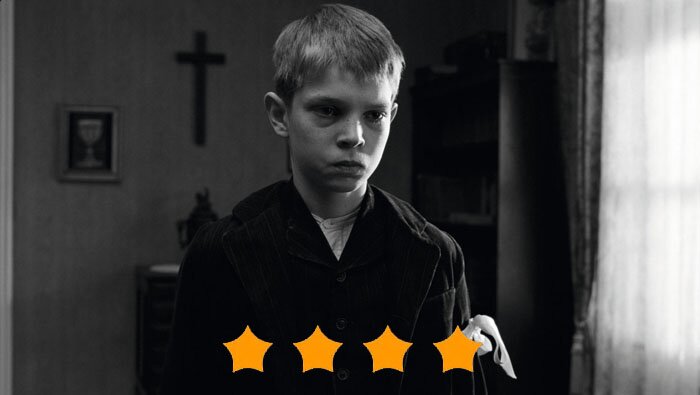
Director: Michael Haneke
Cast: Christian Friedel, Rainer Bock, Ulrich Tukur, Marisa Growaldt
Certificate: 15
A small protestant village, one that serves a Baron, with farming controlled by a devout sense of pietism and education. Everything seems to be in its right place with a well ordained layer of purpose and productivity. The community celebrates with good harvest and chooses the church as its moral compass. Religion and education are the foundations of this world, and all seems well in this black and white vision. At its very opening, though, is a clue to the disorder that will come.
The village doctor is tripped and felled from his horse by a wire stretched between two trees. The Baron’s son is kidnapped and beaten. A farm building is burned down. The Baron believes the son of a farming family, intent on revenge for the accidental work death of his mother, is behind these acts, but soon this easy solution proves fruitless. We are confronted with a world where such an answer is too obvious; there are deeper and more sinister machinations at work, and The White Ribbon's success lies in the obfuscation of what this driving force is. And for this film Haneke chooses to focus on the children as a possible source for these events.
In such a strict world of Protestantism, we are confronted with the notion of rebellion against such a structured society. If the state of society has such a hold then it will surely follow that the reaction will be catastrophic. Haneke manages catastrophe in a very subversive manner – much like a dream; that dreadful feeling where apparently minor events have vast consequences. The children are shown as agents of such a response; we see them first as victims of a strict elder community, then as characters with hidden yet frighteningly powerful control over their lives. And the masterstroke of this theme is how Haneke compliments it with the historical setting of 1913-14; the eve of the First World War.
Are we to see in this setting the vision of the turmoil in Germany to come? These are the children who will reach adulthood during the rise of Nazism, so it would make sense that such a twisted childhood could lead to an equally twisted future. However, Haneke is firm on the idea that this is a film that should not be read strictly as a fable mirroring the rise of fascism in Germany; it is merely a template that can reflect the film's concerns. More importantly, it should be free from historical constraints, allowing a psychological reflection that transcends time to confront the idea of childhood and its darker manifestations.
The film curiously adopts a soap opera style where the concerns of this small community are shown via the many inhabitants within. Enclosures and dark hallways, doorframes and closed doors; these are what stand out when we are in people’s houses. When we are outside we are shown vast landscapes of bleak colourlessness and foreboding visions. These exquisitely, and no doubt painstakingly created, shots belie an acute eye for cinematographic space. Everything is delicately controlled in ways that make you feel the space very strongly. The spinning camera that rotates around the waltzing schoolteacher and his girlfriend has a rushed yet tender feel to it, a blossoming love hurtling foreword yet hemmed in by the claustrophobic community surrounding them.
Haneke’s trademark distancing treats the characters with objective frames, despite the horrific sights we are shown. The acting fittingly adopts a stoic form, particularly in the faces of the most pious in the community. People walk into rooms to be confronted with tragic images - a suicide, paedophilia, violence - only to react with expressionless dismay. This is not exactly light viewing and with its long running time you start to feel bogged down in narrative.
VERDICT
To find yourself immersed within this wonderfully realised setting can only be a point of celebration. For some, it’s a nightmare. Such is the reaction Haneke frequently evokes in audiences.
Tags:
- cache
- cannes
- children
- germany
- hidden
- michael haneke
- nazi
- the white ribbon
|




